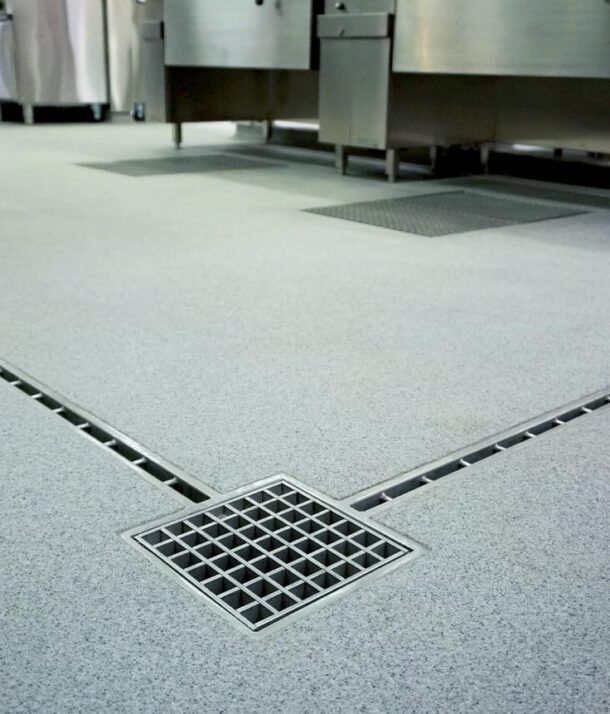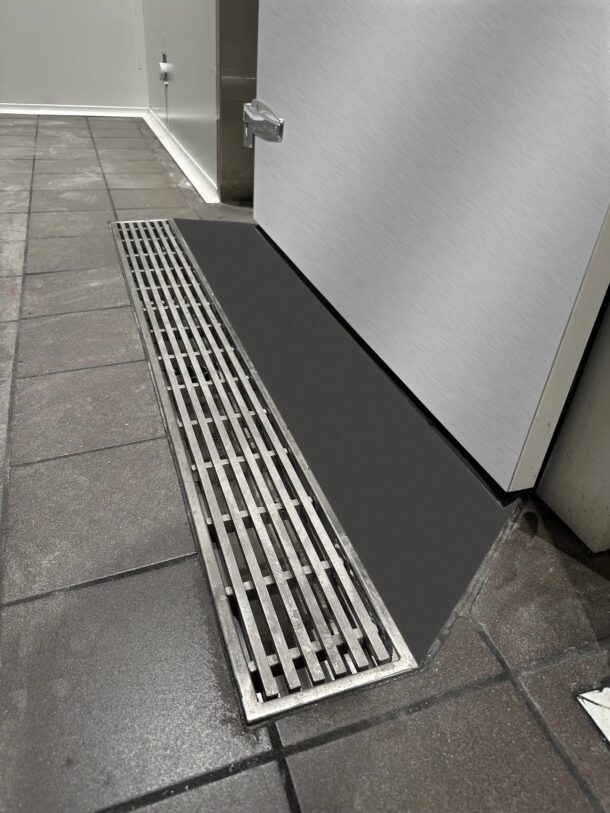Ever walked into a commercial kitchen or industrial facility and noticed those long, narrow drains running along the floor? They’re not just there for looks—they’re trench drains, and when installed properly, they’re game changers for drainage performance and safety.
For plumbers and project managers alike, trench drains are often overlooked until it’s too late. But when you consider the volume of water, debris, and grease that can accumulate in high-traffic commercial areas, it becomes clear – an efficient trench drain system isn’t a luxury, it’s a necessity.

Why Trench Drains Matter in High-Use Environments
Commercial spaces like restaurants, breweries, warehouses, and car parks deal with far more runoff than residential properties. A basic point drain won’t cut it. Trench drains offer:
- Wide surface capture for rapid drainage
- Customisable grates to suit load ratings and slip resistance
- Durability under constant foot or vehicle traffic
They don’t just collect water, they control it. And in a commercial setting, that kind of control prevents costly downtime, water damage, or worse, a slip-and-fall injury.
Grate Selection and Slip Ratings: More Than Just Looks
Choosing the right grate isn’t just about strength—it’s also about safety. Grates come in a range of materials like stainless steel, ductile iron, galvanised steel, and plastic composites. The best option depends on your application. For example, stainless steel is corrosion-resistant and ideal for food-grade areas, while ductile iron handles heavy traffic with ease.
Slip resistance matters too. In Australia, AS 4586 governs slip resistance testing, while the U.S. refers to ANSI/NFSI B101.3. Look for grates that meet R11 or higher slip ratings in wet areas to reduce accident risk. Serrated surfaces, heel-proof slots, and even anti-slip coatings can enhance performance in greasy or moisture-prone environments.
Understanding Load Classes: AS 3996 vs. AASHTO M306
Load ratings help ensure your grate system won’t crack under pressure—literally. In Australia, AS 3996 outlines load classes from A (pedestrian use) to G (aircraft traffic). In the U.S., AASHTO M306 and EN 1433 provide similar guidance.
- Class A (AS): Light pedestrian use, garden paths, patios
- Class C (AS)/H-20 (US): Car parks, light vehicular traffic
- Class D–E (AS)/HS-25 (US): Industrial facilities, loading docks, emergency vehicle access
Always match the drain to the application. Misjudging load class is one of the most common and costly mistakes in trench drain installations.
Design Considerations: Flow Rate, Slope, and Materials
Planning a trench drain system requires more than just digging a channel. Are you working with forklifts or foot traffic? In food prep areas, hygiene and cleanability come first. For outdoor carparks, galvanised steel or polymer concrete channels are ideal for weather resistance.
And then there’s slope. A typical 1% grade (10mm per metre) allows water to flow efficiently, but higher volumes or debris-heavy areas may require a steeper gradient. The U.S. International Plumbing Code (IPC) and Australia’s AS/NZS 3500 both emphasise correct slope for sanitary and stormwater drainage.

Installation Best Practices for Long-Term Performance
Installing trench drains isn’t complex, but it does demand precision. A few centimetres off-level can compromise the entire system. So how do you get it right?
- Plan for the outlet points before pouring concrete
- Use rebar or brackets to stabilise channels during the pour
- Ensure waterproof seals between each channel section
- Match trench depth and width to expected flow rates
Rushed installs and poor preparation often result in weak joins or incorrect elevations. And once the concrete sets, the fix isn’t easy or cheap.
Maintenance Matters: Keeping Drains Functional
Like any system, trench drains need upkeep. Food particles, sediment, or debris can build up quickly. Routine inspection and cleaning is critical, especially in kitchens or auto service bays where fats or oils can cause slow flow or blockages.
Use wet vacs, pressure cleaning, or enzyme-based drain cleaners depending on your environment. And make sure removable grates are regularly checked for corrosion, cracks, or warping.
Case Study: Drainage That Doesn’t Quit
We’ve seen our share of trench drain disasters, but we’ve also helped businesses turn things around. One recent project involved retrofitting a faulty drainage system in a Queensland car wash. Water used to pool around vacuum bays, causing rust and customer complaints. After assessing the layout, the team at Drain Masters Plumbing installed a sloped trench drain system with heavy-duty grates and dual outlets. Not only did the flooding stop, but the owners also saw a boost in online reviews almost immediately.
It’s proof that when drainage works, nobody notices. But when it doesn’t, everyone does.
Final Thoughts: Why Planning Ahead Pays Off
Trench drains might not be glamorous, but they’re critical infrastructure in any commercial plumbing system. The best time to think about drainage is before problems start—not after.
Whether you’re working on a new build or fixing someone else’s mistake, thoughtful trench drain design and installation can mean the difference between a seamless operation and a costly mess. So ask yourself: is your next project built to drain – or built to fail?




Join the conversation: